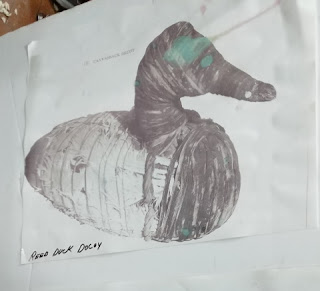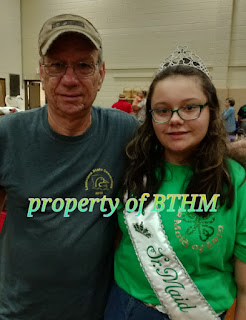So if you saw our post from yesterday, you know Miss Grace attended the Cajun Heritage Festival Queens Day event. The festival is ALL things carved duck related, and features MANY Master Carvers from around the state, vieing for their carved duck titles!
Now we have hunters in the family and we know decoys, but I don't think either of us truly realized just what an ART FORM, they truly are, until an amazing demonstration by Louisiana's own Master Duck Carver, Cal Kingsmill, for the attending queens.
Cal had an AMAZING presentation!
I never knew that duck decoys were actually used by Native Americans. Above is an example of one that was done with reeds and dyed with native dyes. Duck decoys are native to the Americas- its the one irginal folk art, whose prupose has NOT changed from its inception!
Cal prefers to use native southern Tupelo Gum wood, as it is super light for decoys, and does not splinter, making it easy to carve. That block on the right above? It's about 50 pounds! But you could get at least 3 ducks out of it! He uses it as his base to start his ducks on.
He cuts the wood down to the second form you see on the left, and then cuts out the form of the duck with 2 different size HATCHETS. Yup small axes! It's AMAZING to see how quickly he can carve it out! Unfortunately, I was not in a good position to get a picture of him actually carving it out.
Queen Ashley is holding the duck body he carved out from that form you see 2 pictures above, with the 2 axes in literally 10 minutes! (She might have had a moment of sadness for how less realistic older decoys were, as she is on her way to being an amazing carver herself!).And FYI, those ducks on the foreground above? Those are replica of ducks decoys from the 1800s! How cool are they?
You'll notice, it's ONLY the body. He makes his in 2 pieces, so that way he can conserve wood, and reduce the waste. Andwith todays bonding glues, the heads stay put. In earlier days, they woud have used nails to keep them on! Cal also did a great job in showing the girls how they can distinguish between the different ages fo decoys, by how they were made. Modern carvers are able to use better painting techniques and access to so many photographs, to get realistic carvings, without needing to carve all the detail in. Above he is showing how he carves the head into it's natural rounded shape, with the small carving knife. As you can imagine, he said getting the duck bill where it meets the head is the hardest part of the carving!
You can see how the shift from carved to painted, has occurred with these ducks!
These carved ducks are TRULY small works of FUNCTIONAL art. As Cal said, the goal is for the ducks to be USED for hunting, to gain hunters more ducks. THAT is when you know how good of a job you did! But we can admire them as art too! Check out some of the amazing artwork vieing for top spots:
ALL of this tableau is carved wood! The ducks, stump, cattails, all of it!
More than ducks were represented too!
Even the bucket AND berries are carved! It's am AMAZING piece!
New this year at the Fest- carve a feather!!!
Can you tell WHICH one is the real feather and which is wood????
This wasn't even the winner!
This little critter ALMOST came home with us!
He features more intricate carving and staining, to achieve his details,
and is made from ONE piece of wood!
I hope you agree with us that these are great work of arts and be on the lookout if you live in Louisiana for a Louisiana Life special on PBS, featuring Cal coming up VERY soon
(hint, they filmed his demonstration the girls attendd!)















Comments
Post a Comment